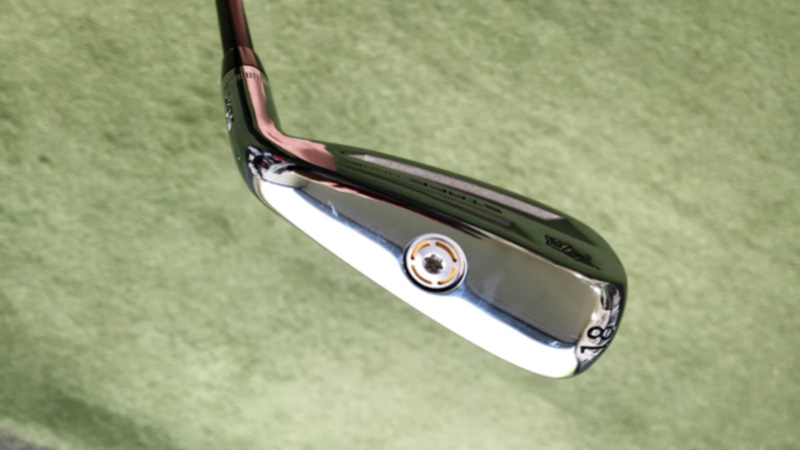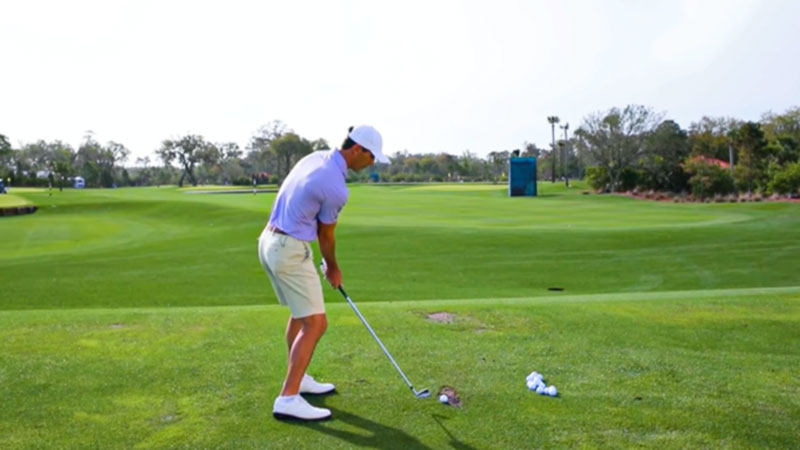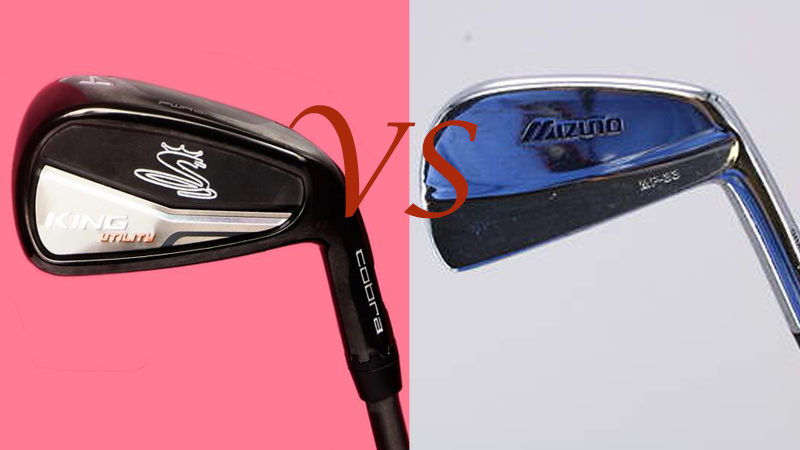When it comes to the world of golf, the equipment you choose can have a significant impact on your performance out on the course. One crucial decision players often face is choosing between a utility iron and a 3 iron.
Both clubs have their strengths and unique characteristics, but determining which one suits your game best requires a closer look.
In this article, we will delve into the differences between a utility iron and a 3 iron, answer some frequently asked questions, and ultimately help you make an informed decision about which club to add to your bag.
What Is Utility Iron?
A utility iron, also known as a driving iron or a long iron replacement, is a type of golf club that bridges the gap between traditional long irons and hybrids.
It’s designed to provide golfers with a versatile option that combines the distance and control of a long iron with the forgiveness and ease of use of a hybrid.
Utility irons typically have a slightly larger clubhead and a lower center of gravity compared to traditional long irons, making them easier to hit and launch.
Pros of Using a Utility Iron
Distance and Control
Utility irons are designed to offer both distance and control. Their design allows for faster ball speeds and higher launch angles, resulting in longer shots while maintaining accuracy.
Forgiveness
The larger clubhead and wider sole of a utility iron contribute to a higher level of forgiveness on off-center hits. This means that even when you don’t strike the ball perfectly, you’re more likely to achieve a decent shot outcome.
Versatility
Utility irons can be used in a variety of situations. They can be effective off the tee, from the fairway, or even out of light rough. This versatility makes them suitable for various course conditions and shot requirements.
Workable Trajectory
While utility irons offer forgiveness, they also allow skilled players to shape shots. With proper technique, you can manipulate the trajectory and flight of the ball, giving you more options to navigate the course.
Cons of Using a Utility Iron

Skill Required
While utility irons are more forgiving than traditional long irons, they still require a certain level of skill to consistently strike well. Novice golfers might find them challenging to master.
Limited Shot Shaping
While utility irons offer some shot-shaping capability, they may not provide the same level of workability as traditional irons. Skilled players who value precise shot shaping might prefer other options.
Adjustment Period
Transitioning from long irons to utility irons can take time. The different feel and performance characteristics might require adjustments to your swing and setup.
Not Suitable for All Players
Players with very low handicaps who prefer the precision and shot-making abilities of traditional long irons might not find utility irons to be a perfect fit for their game.
In the end, choosing to include a utility iron in your golf bag depends on your playing style, skill level, and preferences.
If you’re seeking a club that combines the best of both worlds—distance, control, and forgiveness—a utility iron could be an excellent addition to your arsenal.
However, as with any golf club, it’s essential to try it out, get fitted, and practice with it to ensure that it complements your game and enhances your overall performance on the course.
What Is 3 Iron?
The 3 iron is a traditional long iron that has been a staple in golf bags for decades. It’s part of the set of irons and is usually numbered 3, indicating that it has a lower loft and is designed to hit longer shots.
The 3 iron features a smaller clubhead and a more compact profile compared to utility irons and hybrids. It requires a higher level of skill to hit consistently well but offers greater shot-shaping capability and precision for skilled players.
Pros of Using a 3 Iron
Shot Shaping
Skilled golfers often favor 3 irons for their ability to shape shots precisely. The smaller clubhead and more traditional design allow for greater control over the trajectory and spin of the ball.
Control
The compact design of the 3 iron offers a higher level of control over the ball flight. This can be especially useful for navigating tight fairways, avoiding hazards, and hitting approach shots into greens with precision.
Versatility
The 3 iron can be used for a variety of shots, including long approach shots, tee shots on tight par-3s, and low-trajectory shots to combat wind conditions. Its versatility makes it a valuable tool for experienced golfers.
Workable Trajectory
The design of the 3 iron allows skilled players to manipulate the trajectory of their shots, offering flexibility in adapting to different course conditions and situations.
Cons of Using a 3 Iron

Difficulty
The smaller clubhead and lower forgiveness of the 3 iron make it more challenging to hit consistently well, especially for mid to high handicappers. It requires a precise and consistent swing to achieve optimal results.
Limited Forgiveness
The compact design of the 3 iron means that mishits are less forgiving compared to larger clubheads like those found in utility irons or hybrids. Off-center hits can result in reduced distance and accuracy.
Less Distance
In general, 3 irons may not provide the same level of distance as utility irons. The lower loft and design make it harder to generate high ball speeds, which can lead to shorter shots.
Skill Dependent
Due to its demanding nature, the 3-iron is better suited for experienced players with consistent swings. Novice golfers might struggle to hit it consistently well, potentially affecting their confidence and enjoyment on the course.
Deciding whether to include a 3 iron in your golf bag depends on your playing style and skill level. If you’re a skilled golfer who values shot shaping, precision, and control, the 3 iron could be a valuable asset.
However, if you’re still refining your swing and seeking more forgiveness and distance, you might find utility irons or hybrids to be more suitable options.
Utility Iron Vs 3 Iron: Basic Differences
In the world of golf, the choice of equipment can significantly impact your game. When it comes to utility irons and 3 irons, there are fundamental differences that can influence your decision on which club to include in your bag.
Let’s explore the basic distinctions between these two clubs to help you make an informed choice based on your playing style and preferences.
Club Design
Utility Iron
- A utility iron is designed as a hybrid between traditional long irons and hybrids.
- It features a larger clubhead and a lower center of gravity for improved forgiveness and easier launch.
- The design prioritizes a balance between distance, control, and forgiveness.
3 Iron
- A 3 iron is a traditional long iron with a smaller clubhead and a more compact profile.
- It offers skilled players the ability to shape shots and provides greater shot control.
- The emphasis is on precision and shot-making, rather than forgiveness.
Forgiveness and Playability
Utility Iron
- Utility irons are known for their forgiveness due to the larger clubhead and wider sole.
- Mishits are less punishing, and the ball tends to perform well even on off-center strikes.
- This makes utility irons suitable for players seeking consistent performance without sacrificing forgiveness.
3 Iron
- The smaller clubhead of the 3 iron offers less forgiveness on off-center hits.
- Skilled players can achieve desired shot outcomes, but it requires a consistent and accurate swing.
- The 3 iron is better suited for players who prioritize precision over forgiveness.
Distance and Control
Utility Iron
- Utility irons generally offer more distance compared to traditional long irons like the 3 iron.
- The design allows for higher ball speeds and easier launch, resulting in longer shots.
- They provide a balance of distance and control, making them versatile for various situations.
3 Iron
- While not as forgiving, the 3 iron provides greater shot control and workability.
- Skilled players can manipulate the trajectory and shape of shots for specific course scenarios.
- It might not offer the same distance as a utility iron, but it compensates with shot-shaping capabilities.
Choosing the Right Club
The decision between a utility iron and a 3 iron boils down to your skill level, playing style, and preferences. If you’re a higher handicapper looking for forgiveness and distance, a utility iron might suit you better.
On the other hand, if you’re a skilled player who values shot shaping and precision, the 3 iron could be the right choice.
Ultimately, both utility irons and 3 irons have their strengths, and your decision should align with your strengths and goals on the golf course.
Trying out both clubs, getting professional advice, and considering your performance priorities will guide you toward selecting the club that enhances your overall golfing experience.
Which One Should I Choose Among Utility Iron and 3 Iron?
Choosing between a utility iron and a 3 iron depends on your playing style and skill level. If you prioritize forgiveness, versatility, and extra distance, the utility iron could be your pick.
Its larger clubhead and lower center of gravity offer forgiveness on off-center hits, making it suitable for higher handicappers. However, if you’re a skilled player seeking precise shot shaping and greater control, the 3 iron might be the better choice.
While less forgiving, its compact design enables workable trajectories and accurate shots. Consider your strengths and preferences—opt for the utility iron for forgiveness and distance, or go for the 3 iron if control and shot shaping matter most.
Ultimately, your decision should reflect the strengths you want to capitalize on during your rounds on the course.
Things to Consider While Choosing the Right Iron for Golf
Selecting the right iron for your golf game is a decision that can significantly impact your performance on the course. Here are essential factors to consider when making your choice:
Skill Level
Assess your skill level honestly. If you’re a beginner or mid-handicapper, prioritize forgiveness and ease of use. Skilled players might lean towards clubs that offer greater control and shot-shaping.
Playing Style
Think about your playing style and strengths. Are you a player who relies on consistency and accuracy, or do you enjoy shaping shots and taking on more challenging approaches?
Distance Requirements
Consider the typical distances you need to cover during a round. If you need more distance, utility irons or higher-numbered irons might be beneficial.
Forgiveness vs. Control
Determine your balance between forgiveness and control. Utility irons offer forgiveness on mishits, while traditional irons like the 3 iron provide better shot control.
Course Conditions
Think about the courses you play. If they have wide fairways and forgiving rough, forgiveness might not be as crucial. On tighter courses, control becomes more valuable.
Swing Speed
Your swing speed can influence the club’s performance. If you have a slower swing, clubs that generate more launch and ball speed might help cover more distance.
Trial and Fitting
Before making a final decision, try out both utility irons and traditional irons. Professional club fitting can provide insights into the right clubhead design, shaft, and loft for your swing.
Versatility
Consider the versatility of the club. Can it handle various situations, such as tee shots, fairway approaches, and recovery shots?
Confidence
The club you choose should inspire confidence in your swing. Feeling comfortable and confident with a club in your hand can lead to better performance.
Long-Term Goals
Consider your long-term goals in golf. Are you looking to improve your skills and transition to more demanding clubs over time, or do you prefer clubs that will be relevant for a longer period?
Balancing Your Bag
Think about how the chosen iron fits into your overall club set. Ensure a balanced selection of clubs to cover various distances and shot types.
Personal Preference
Lastly, factor in your personal preferences. The “feel” of a club can impact your performance, so choose the one that resonates with you.
There’s no one-size-fits-all answer. The right iron for you depends on a combination of these factors. Consider your individual strengths, weaknesses, and playing objectives to make an informed choice that enhances your golfing experience and helps you perform your best on the course.
FAQs
What is a Utility Iron?
A utility iron, often referred to as a driving iron or a long iron replacement, is designed to provide the distance and control of a long iron with the forgiveness and versatility of a hybrid.
It typically has a slightly larger clubhead and a lower center of gravity, making it easier to launch the ball off the tee or from the fairway.
What is a 3 Iron?
The 3 iron is a traditional long iron that has been a staple in golf bags for decades. It features a smaller clubhead and a more compact profile compared to utility irons.
While it requires a higher level of skill to hit consistently well, it offers greater shot-shaping capability and precision in the hands of skilled players.
Which Club Offers More Forgiveness?
In terms of forgiveness, the utility iron has the edge due to its design. The larger clubhead, wider sole, and lower center of gravity contribute to a higher level of forgiveness on off-center hits.
This makes the utility iron a suitable choice for players who want consistency without sacrificing too much control.
Which Club Provides Better Distance?
Generally, a utility iron tends to offer more distance compared to a 3 iron. The design of a utility iron allows for greater ball speed and higher launch, resulting in longer shots.
However, it’s essential to note that individual differences in swing speed and technique can influence the distance you achieve with each club.
Which Club Should one Choose from Utility Iron or 3 Iron?
The choice between a utility iron and a 3 iron depends on your skill level, playing style, and preferences. If you’re a higher handicapper or seeking more forgiveness and distance, the utility iron might be the better option.
On the other hand, if you have a consistent swing and value shot-shaping ability, the 3-iron could be a great fit.
Wrapping Up
Selecting the right club between a utility iron and a 3 iron can significantly impact your performance on the golf course. While the utility iron offers forgiveness and distance, the 3 iron provides shot-shaping precision and control.
As you make your decision, consider your skill level, playing style, and the type of shots you often encounter.
Ultimately, both clubs have their merits, so the key is to choose the one that aligns with your strengths and helps you navigate the challenges of the game with confidence.
Thank you for your time.







